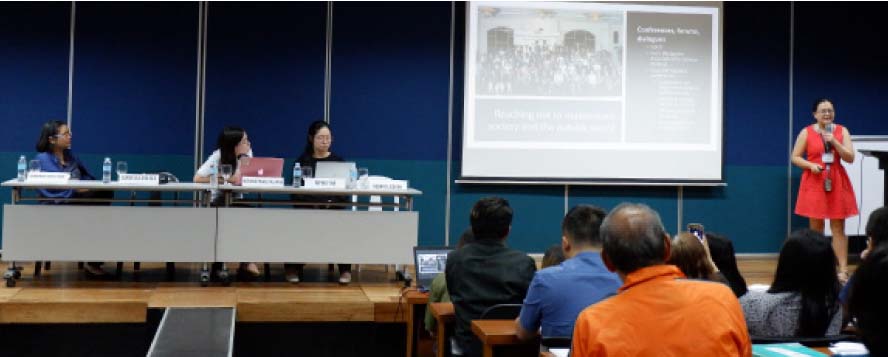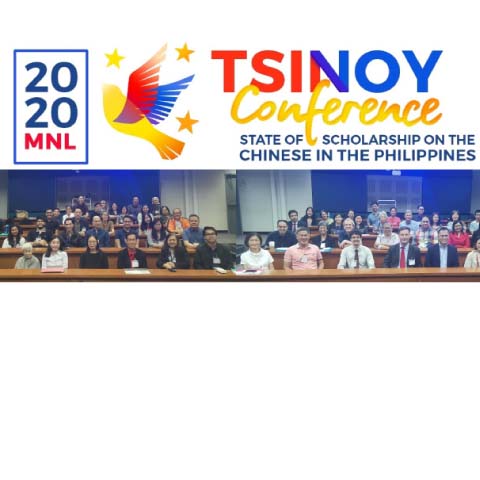
Tsinoy 2020 was not just about the phenomenon of Chinese living in the Philippines, calling this nation of islands home. It was a gathering of thoughtful scholars, historians, sinologists and people who became interested in the history and heritage of the Chinese as vital contributions to Philippine studies.
German sinologist Prof. Martin Woesler, at the opening of Tsinoy 2020, noted that in the world of Chinese studies, “science and scholarship… provide information to encourage better understanding.
“Philippine-Chinese studies and Chinese-Philippine studies have contributed to creating a different image of the respective other country, which is based on facts instead (of) political agendas.
“You are writing another passage in the history of Chinese studies in the Philippines with this conference, which covers an interesting range of topics, such as politics, migration, identity, sinophobia, traditional Chinese medicine, manuscripts, relation and lineages,” he said.
Woesler is president of the World Association for Chinese Studies.
Nearly 100 delegates participated in this year’s Tsinoy 2020: International Conference on the State of Scholarship on the Chinese in the Philippines, held on Jan. 10 and 11 at Miriam College, Loyola Heights, Quezon City.
Five panels spanned topics related to history, humanities, language, education, migration, family histories and identity.
Teresita Ang See, as one of the convenors and keynote speakers, talked about synergy and synchronicity in Philippine studies, Chinese studies and Chinese in the Philippines studies. The other keynote speaker, Dr. Tina Clemente, reviewed Chinese studies in the Philippines and analyzed future directions.
Ang See provided a rich source of archival resources in Chinese, English and Spanish, which Kaisa Para Sa Kaunlaran has gathered through the years. She also shared her dream of being in a situation where all studies on the Chinese in the Philippines can come together to influence government policies.
Clemente discussed how the domains and structures of Chinese studies, not only in the Philippines but also in the international arena, differ per institution. The studies cover overseas Chinese studies, Chinese studies in the Philippines, Tsinoy studies, and Philippine-China relations. Chinese studies also intersect with other fields.
Therefore, it is important to keep enriching and progressing it, she stressed.
The closing plenary sessions were well received, with Dr. Rommel Banlaoi speaking about joint counter-terrorism operations between the Philippines and China under the Duterte administration.
Despite territorial disputes, the two countries have benefited from cooperation on dealing with terrorism, which threatens both nation’s interests.
Such cooperation also diverted bilateral relations away from the disputes in the South China Sea. However, even in this area, Chinese studies play a major role. Each country has its own interpretation and perception of security threats. There are varied policies, as well as institutional and bureaucratic arrangements, related to counterterrorism in both nations.
People-to-people dialogue, therefore, creates a better understanding on both fronts, and helps smooth out the process.
Another speaker, Reynard Hing, in a joint presentation with Ang See, discussed rising ethnic tensions and racial conflict directed towards Chinese nationals living in the Philippines, a major adverse consequence of Philippine offshore gaming operators (Pogos)’s presence.
China and Chinese issues, such as the illegal drugs trade, extortion cases, human trafficking, overstaying aliens, and an overall disruption to social order, all contribute to antagonism toward Tsinoys, who are caught in the middle.
Incidents reported in the news – such as crimes and raids on drug laboratories, sham marriages for businesses, and resentment toward the present administration’s friendliness to China despite ongoing territorial disputes – further fuel racial conflict.
Hing provided much insight into the illegal activities that Chinese criminals are involved in. These acts are openly advertised on WeChat platforms, resulting in a multi-pronged assault on China’s image, Philippine-China relations, China’s policies regarding overseas Chinese, the Tsinoy community, and the perception of Chinese mainstream communities.
Talks as diverse as people
Topics treated in the panels were as diverse as the discussants. They included local histories, migration, manuscripts, acupuncture, ancient trade and diplomatic relations from ancient times to the present.
In contemporary society, issues discussed included the search and formation of cultural identities of descendants of the early migrants, and sinophobia and racism as the result of unwelcome – sometimes criminal – behavior of Chinese nationals outside of their country.
Prof. Aurora Roxas-Lim of Ateneo de Manila University, Loyola Heights, Quezon City, spoke about the role of the ethnic Chinese in global maritime trade from the 10th century onwards. Pre-colonial trade between China and the kingdoms of Southeast Asia was inevitable, as people in these countries were boat builders and relied heavily on maritime trade.
For his part, Dr. Randy Madrid of the University of the Philippines Visayas, Iloilo, talked about the history, identity and cultural formation of the Chinese community in Iloilo. He used urbanization as a framework to understand the presence of ethnic Chinese there. He highlighted the presence of food and other artifacts that were a mix of Ilonggo and Chinese influences. He identified Jaro, Oton and Molo as the cities where major Chinese influence in Iloilo resonate. As in many other cities and towns across the country, the role and presence of the ethnic Chinese in Iloilo have helped shape their cultures and identities.
Going further back in history, research on Chinese vagrants and social outcasts in 19th century Philippines came from Dr. Jely Galang of the University of the Philippines, Diliman, Quezon City. Primary source evidence revealed that they were from the laboring class and labeled as dangerous and undesirable. Galang presented details on the backgrounds of these criminals, including ages, types of crimes and occupations.

Centuries of Taiwan-PH relations
Dr. Phillip Guingona of Wells College, New York, did a comparative study on Chinese and Filipino migrants. He illustrated the commonalities between Shanghai’s Filipino community and the Philippines’ Chinese community. Comparing diasporas uncovers common factors that produce shared experiences between the two communities. His study provided a different way of observing diasporas, which he termed a “mirrored diaspora,” where both migrant communities share similarities not outlined in other seminal studies on diaspora.
From the National University of Singapore, Dr. Chien-Wen Kung followed the story of the Chinese Commercial News and how Taiwan’s Kuomintang ruling party in the 1970s supported the Philippine military in persecuting brothers Rizal and Quintin Yuyitung, on suspicion that they and the newspaper supported communism. Kung labeled the KMT as a “government within a government,” because it indirectly attacked liberal Filipino journalists at the time.
Relationships between the Philippines and Taiwan five centuries ago was the topic of Patrick Stein of Reed College, Portland, Oregon. He spoke of the early diplomacy between the two during the late 1600s, when the Philippines was still a Spanish colony.
He analyzed a 1663 letter from Zheng Jing addressed to the Spanish authorities, which essentially asked for peace and contained various requests, such as returning the property of merchants and improving the treatment of both Chinese and Filipinos. The document is an unprecedented diplomatic document and, interestingly, was written during an era of supposed diplomatic distance.
Zheng Jing was a Fujian-born warlord in the 17th century, and ruled the Kingdom of Tungning (or Kingdom of Formosa) in Taiwan. He was the son of renowned Chinese rebel Zheng Chenggong (Koxinga). And like his father, Zheng was a Ming loyalist who refused to accept the Qing conquest of China.
Acupuncture, archives, social media
As a certified acupuncturist, Johanna Marie Astrid Sister of the SMIC-Institute of Traditional Chinese Medicine explored the history of acupuncture in the Philippines. Acupuncture is now recognized as an important practice in alternative medicine. But her research reveals the dearth of acupuncture centers in the country, as well as the proliferation of Korean acupuncturists around Metro Manila.
This author discussed new narratives and resources on the Chinese in Southeast Asia and the Philippines. The downside of these new archival resources is the language barrier, because most of them were in Chinese.
Niping Yan from the University of British Columbia, Vancouver, Canada presented part of her dissertation, entitled, “Sangleys and the Boxer Codex: Unequal presence and the making of a Spanish manuscript in the 1590s.” Yan conducted significant analyses on the illustrations contained within the Boxer Codex, revealing Spanish and Chinese influences.
The youngest speaker at the conference, Michiko Pearl Palaran, a new graduate of the University of the Philippines Diliman, presented her paper that relates to the current experiences of young Tsinoys. It explains how Chinese-Filipinos are perceived through the lens of Chinese-Filipino influencers on social media. She highlighted media’s critical role in forming the Chinese-Filipino identity, and how media representation affects the construction of knowledge, values and beliefs.

The family tree speaks
Writer and teacher Carla Pacis of De La Salle University, Manila shared her family biography going back three generations of the Syquia family of Vigan, Ilocos Sur. Her discovery of her roots made her question the life once lived by her ancestors. Her research also presents itself as a microcosm of Chinese migrants and how their descendants evolved into mestizos and Filipinos.
Oded Abt of Tel Aviv University, Israel, talked about the “Manila Muslim Five-Surname Association” and how their family biographies transcend culture, race and religion. He traced the earliest Persian ancestor to a Muslim trader who settled in Quanzhou, China in the early 14th century.
His descendants then spread far and wide from their village in Baiqi Township to Taiwan, Manila, Malaysia and Indonesia. While these descendants no longer practice Islam, the discovery of the Quran and other historic materials yielded interesting links that commemorated their Muslim heritage.
Beginning with his own search for his roots, Tulay writer Eduardo Chan Dela Cruz shared his unique job as the “relative finder.” Dela Cruz has connected over 30 families in the Philippines to long-lost relatives in China. Find out more about these searches in previous issues of Tulay Fortnightly.
Finding your cultural identity
American Dr. Diego Luis of Brown University, Rhode Island, US, presented the origins of sinophobia in the early Philippines. As a historian of Latin America and the Pacific, Luis discussed the 1603 Chinese uprising in Manila as an important turning point in the formation and spread of sinophobia throughout Spanish colonialism.
Serina Mae Alonzo from De La Salle University explained the concept of “identity envy” among third generation Tsinoys. She mentioned the importance of language as an identity marker and media representation, as it affects the perceptions of society towards one another.
Her research also focused on third generation digital natives on who are influenced by digital media. Viewing Chinese-Filipinos as landing on a spectrum, and there are those who cling closely to their heritage, those who are more integrated, and those in the middle who are more prone to identity crises.
History professor and Tsinoy Dr. Richard T. Chu of the University of Massachusetts-Amherst presented his comparative studies on the Chinese in the colonized Latin American countries of Trinidad and Tobago, Panama and Cuba. The colonial histories of these countries are similar to that of the Philippines, Chu said. So there are lessons to be learned when reviewing the development of Chinese communities in these countries.
In closing, keep talking
Chinese studies in the Philippines have to be viewed under the context of global Chinese studies. At the closing plenary session, Woesler stressed the importance of dialogue, especially in these times of rising tension. People-to-people exchanges do much to dispel misunderstandings, and the duty to keep dialogues going lies on both the Chinese communities of the world and their host countries. — with inputs from Bea Bakabak, Joyce Magan and Shenina Badua; photos by Annathea Balgoa.





